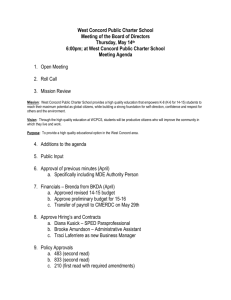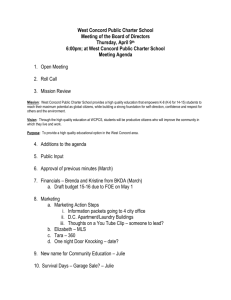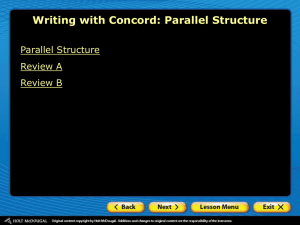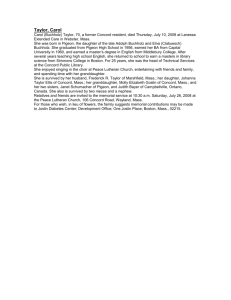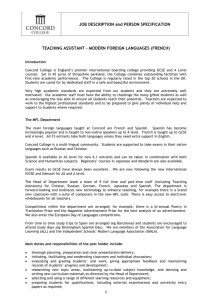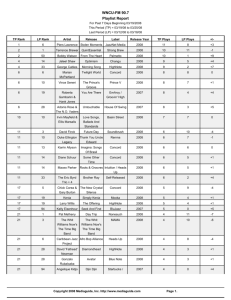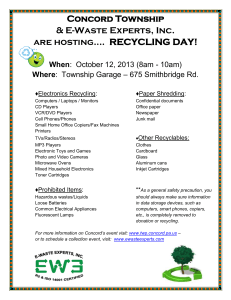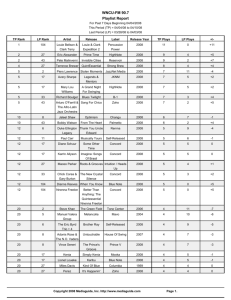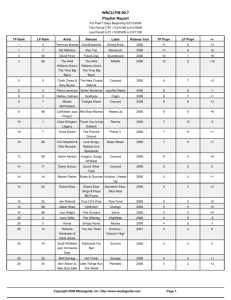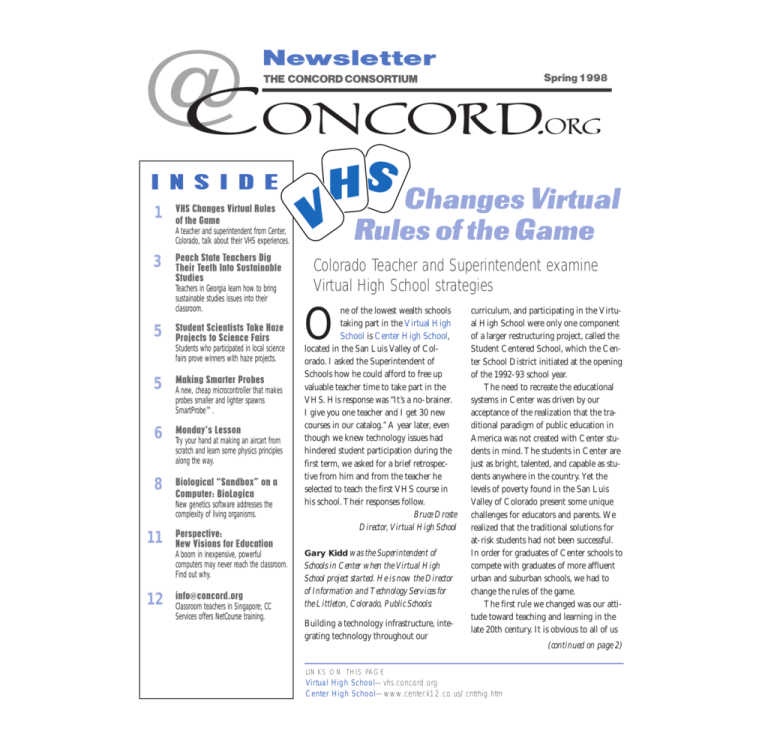
@
CONCORD.
Newsletter
Spring 1998
THE CONCORD CONSORTIUM
ORG
I N S I D E
1
VHS Changes Virtual Rules
of the Game
A teacher and superintendent from Center,
Colorado, talk about their VHS experiences.
3
Peach State Teachers Dig
Their Teeth Into Sustainable
Studies
Teachers in Georgia learn how to bring
sustainable studies issues into their
classroom.
5
Student Scientists Take Haze
Projects to Science Fairs
Students who participated in local science
fairs prove winners with haze projects.
5
Making Smarter Probes
6
Monday’s Lesson
8
Biological “Sandbox” on a
Computer: BioLogica
A new, cheap microcontroller that makes
probes smaller and lighter spawns
SmartProbe™.
Try your hand at making an aircart from
scratch and learn some physics principles
along the way.
New genetics software addresses the
complexity of living organisms.
11
Perspective:
New Visions for Education
A boom in inexpensive, powerful
computers may never reach the classroom.
Find out why.
12
info@concord.org
Classroom teachers in Singapore; CC
Services offers NetCourse training.
S
H Changes Virtual
V Rules of the Game
Colorado Teacher and Superintendent examine
Virtual High School strategies
ne of the lowest wealth schools
taking part in the Virtual High
School is Center High School,
located in the San Luis Valley of Colorado. I asked the Superintendent of
Schools how he could afford to free up
valuable teacher time to take part in the
VHS. His response was “It’s a no-brainer.
I give you one teacher and I get 30 new
courses in our catalog.” A year later, even
though we knew technology issues had
hindered student participation during the
first term, we asked for a brief retrospective from him and from the teacher he
selected to teach the first VHS course in
his school. Their responses follow.
Bruce Droste
Director, Virtual High School
O
Gary Kidd was the Superintendent of
Schools in Center when the Virtual High
School project started. He is now the Director
of Information and Technology Services for
the Littleton, Colorado, Public Schools:
Building a technology infrastructure, integrating technology throughout our
curriculum, and participating in the Virtual High School were only one component
of a larger restructuring project, called the
Student Centered School, which the Center School District initiated at the opening
of the 1992-93 school year.
The need to recreate the educational
systems in Center was driven by our
acceptance of the realization that the traditional paradigm of public education in
America was not created with Center students in mind. The students in Center are
just as bright, talented, and capable as students anywhere in the country. Yet the
levels of poverty found in the San Luis
Valley of Colorado present some unique
challenges for educators and parents. We
realized that the traditional solutions for
at-risk students had not been successful.
In order for graduates of Center schools to
compete with graduates of more affluent
urban and suburban schools, we had to
change the rules of the game.
The first rule we changed was our attitude toward teaching and learning in the
late 20th century. It is obvious to all of us
LINKS ON THIS PAGE
Virtual High School—vhs.concord.org
Center High School—www.center.k12.co.us/cntrhig.htm
(continued on page 2)
The Concord Consortium
Editor
Robert F. Tinker
Managing Editor
Lee McDavid
@CONCORD is published three times a
year by the Concord Consortium, a notfor-profit educational research and
development organization dedicated to
educational innovation through creative
technologies.
Copyright ©1998 by the Concord Consortium. All rights reserved. This publication
may be reproduced for noncommercial uses
without written permission, provided
appropriate acknowledgment of the Concord Consortium accompanies the reproduction.
The Concord Consortium
37 Thoreau Street, Concord, MA 01742
(978) 369-4367, FAX (978) 371-0696
info@concord.org
http://www.concord.org
The projects described in @CONCORD
are supported by grants from the National
Science Foundation REC-9553639, REC9896075, REC-9725524, REC-9554198,
ESI-9896068, ESI-9554162 and CDA9720384, and the U.S. Department of
Education R303A60571 AND
R303A70182.
We also receive donations from corporations and individuals. All opinions,
findings, conclusions, and recommendations expressed herein are those of the
authors and do not necessarily reflect the
views of the funding agencies.
Rules of the Game
continued from page 1
referred to as the “Nintendo generation” or
the “ ’Net generation.” They live in a world
which is increasingly interactive, communications intensive, and knowledge based.
They are the standard bearers in the information revolution, having never known
anything else. Because of their ease in and
with the information age, society needs
their active involvement and interaction.
The concept of education is being
redefined by a world we can barely imagine. Everything we have known as reality
is going to be challenged or changed, yet
our challenges are undefined. What is
going to happen by the time our current
generation of students leaves our high
schools? We have the responsibility to let
go of the past in order to embrace the
future. And the future has arrived; it just
hasn’t been evenly distributed.
involved in the Virtual High School program that students today are different than
they were ten years ago. Yet many teachers
are still teaching the same material in the
same way. Everything in the old paradigm
was designed to be taught without technology. Hence, the first 15 months of our
restructuring around technology was spent
questioning everything. We kept some
things, eliminated others, and revised the
remaining. At that point in the process,
most of our hardware was three generations behind the curve, but so were our
attitudes. I presume the same is true in
most schools today, despite what most of
us like to believe. As a consequence, before
we installed a single new computer, we
started 15 months of extensive staff development. Put simply, our attitudes
Terri Day has taught science at Center High
determine the ways we think; how we
School for 10 years and is teaching Introducthink determines our actions.
tion to Microbiology for VHS:
Our district vision statement speaks to
our commitment to our people, our comMy experiences with Virtual High School
mitment to partnership, and our
have reminded me of my first year or two
commitment to excellence. Through the
of teaching. I have had those same feelings
work of our staff
of trying to stay
and their willingcaught up with the
I have really enjoyed planness to provide
students and
ning
a
course
that
I
would
the opportunities
working hard to
all of our stuget everything
never get to teach in my
dents deserve,
organized.
district because of small
and the commitLearning new
ment of a
software made
enrollment and small staff.
community to
those feelings of
accept the challenge
not knowing how
of change on behalf our students, we have
everything in the school
created a learning environment very differ- works come up again, also.
ent from the school district of four years
I have really enjoyed planning a course
ago. We have created an environment
that I would never get to teach in my diswhich personifies our vision.
trict because of small enrollment and small
Children have always been explorers,
staff. We are able to offer the basic courses
born with the ability to interact and learn
with a few advanced ones, but none as
about the world around them. Children
specialized as this course. Although the
between the ages of three and 18 are being planning and implementation of this
LINKS ON THIS PAGE
Virtual High School—vhs.concord.org
Center High School—www.center.k12.co.us/cntrhig.htm
Page 2
Concord Consortium: www.concord.org
course took many, many hours of my time,
I enjoy this aspect of the Virtual High
School. It allows me to get excited about
my field again.
Some aspects of teaching a VHS
course are the same as a “real” course. I
found that the students fall into predictable personality types. I have students
that are really self-motivated and can follow directions without any extra help,
some need a little extra push but then
move along well, and those that just “don’t
get it” no matter how much instruction
they receive or how much push I provide.
They are no different than my “real” students. I remember wondering whether I
could get to know my virtual students very
well through this type of learning, but I
feel that I do know them.
As with any course, I am constantly
refining and modifying the lessons as
needed. A course is never done, never
exactly the way you envision. This is particularly true with courses that rely heavily
on information from the Internet, which
my course does. These students visit web
sites for the information they need to
complete the course. Sometimes these
sites change from one week to another, so
I spend a lot of time going back to my
original sites looking for changes and then
refining the lessons accordingly. I also
spend time looking for new sites that
would be helpful for my students.
VHS has allowed me to grow as a
teacher. Although it takes time, I have
enjoyed learning lots of new techniques
that apply to all classes, not just virtual
ones. I hope that this experience has made
me a better teacher, I know I have become
a better learner. @
Peach State Teachers
Dig Their Teeth into
Sustainable Studies
by Jack Byrne
ustainability is a complicated
topic. In March, 50 teachers
from the Cobb and Fulton County
(Georgia) School districts took up the
challenge to begin developing classroom
materials that would explain sustainability
to their students. Whether teaching
kindergarten or high school, these teach-
S
Dr. George Stickel from Harrison High School in
Cobb County, Georgia, presents a small group
report to the ESF participants.
ers began the task of incorporating
sustainability issues into their varied curriculums.
But first, they had to agree on why it
was important to do so, especially when it
meant learning new technology tools to
support their teaching curriculum.
“It is important . . . because [teachers]
are the bridge between such a future and
the kids who will shape it,” one group of
teachers replied.
They all agreed that kids are the key
to the future. “One teacher said it was like
a treasure chest and we have the key,” said
Donna Culver, the facilitator at the workshop, which was an orientation for
Education for a Sustainable Future (ESF),
a project of Concord Consortium’s Center
for a Sustainable Future (CSF) and the
Cobb County Public Schools (@CONCORD, Winter 1998).
More than 250 K-12 teachers applied
to participate in this first round of curriculum development, and this was the first
time the selected teachers had met.
Dr. Richard Benjamin, Superintendent
of Cobb County Schools and co-Principal
Investigator of the project, noted that as a
superintendent it is easier for him to find
out who attended school each day than
what it was that each child was learning.
“We have a situation where attendance is
mandatory and learning is optional,” he
said.
A key component of the ESF project
is the use of technology tools, such as
computers and the Internet, to help students understand local and worldwide
sustainability issues. Benjamin expressed
his hope that the ESF project will lead the
way in this respect. Two ESF web sites
(see URLs below) have already made
available a number of items, such as a
resource database, a bookstore, a calendar
of events, a sample curriculum template,
and other features.
Teachers were able to experience the
immediacy of an online chat session when
they logged on to talk with Keith Wheeler, the ESF co-Principal Investigator, from
Vermont. A “contagious enthusiasm”
among the teachers in the chat session
(continued on page 4)
LINKS ON THIS PAGE
VHS—vhs.concord.org
ESF—csf.concord.org/esf
Concord Consortium: www.concord.org
CSF—csf.concord.org
Harrison High School—www.cobb.k12.ga.us/~grants/particip.htm
@CONCORD Winter 1998—www.concord.org/pub.html
Page 3
Peach State Teachers
continued from page 3
made it evident how communication can
be enhance by technology.
There still remained the development
of a definition of sustainability. “We started with a picture of a tree,” explains
Donna Culver, “with three main roots—
quality of life, a prosperous economy, and a
healthy environment—and we described
what those things mean in their local
community.” Thinking locally is crucial to
gaining a clearer understanding of sustainability. It’s easier to talk first about how
water quality, air quality, urban sprawl, and
transportation affect your community
before thinking about global issues.
In order to understand their communities better, participants discussed a short
version of a Community Cultural Profile,
a series of questions about different characteristics of a community. Here are some
examples:
v
Where do people in your community
see each other on a regular basis (e.g.,
town meetings, parks, grocery stores,
shopping malls)?
v
In general, what kinds of opportunities exist to get involved in
community activities?
v
What percentage of people who live
in your community work in the community? Outside the community?
Do you have any thoughts on why
these trends are occurring?
v
Is telecommuting on the rise?
Many of the groups found themselves
discussing the meaning of the word “community.” The workshop itself represented a
community they had formed that day.
Each person was part of a geographic
community. And many were also members
of virtual communities. One person was
inspired to organize a group from his geographic community in order to discuss the
questions back home.
“I explain sustainability this way,” says
Culver, “if our communities are a trust
fund, we can only touch the interest, not
the principle.”
Now imagine what your community
would be like if you used only the interest,
or if you dug into the principle. If the
result was represented by the branches of
the tree, what would your community look
like twenty years from now? One group of
teachers chose to represent both scenarios
and came up with a tree that was alive and
vigorous on one side and sickly and
drooping on the other. They agreed that
the healthy side was a result of positive
sustainable actions, represented by the
three agreed upon tenets: quality of life, a
prosperous community, and a healthy
environment.
After beginning with a shaky understanding of sustainability, it was apparent
that these teachers were quickly developing a realistic sense of the current
challenges facing their community and
optimism about their ability to create a
more sustainable future.
But how to bring this understanding
to the classroom? Teachers explored the
connections between the subjects and
grades they taught, taking advantage of
the wide experience that the assembled
teachers had in K-12 classrooms.
“Stewardship” became an important
topic when connecting teaching and sustainability. Participants brainstormed
connections between their teaching roles
and the following:
v
An understanding of 1) resource allocation, use, and renewal, and 2) the
responsibility society has to make
these resources available to future
generations.
v
Individuals, institutions, and corpora-
tions taking full responsibility for the
social, environmental, and economic
consequences of their actions.
The day ended with a presentation by
Jim Hartzfeld of Interface Research, a
subsidiary of Interface Corporation, a $1.2
billion a year tile, carpeting and flooring
company. Interface is an example of a
company which has changed its corporate
vision to embrace sustainability throughout their worldwide operations. Their
introduction to a recently published a corporate sustainability report states:
There are no federal agencies regulating sustainability, no charts or
graphs to tell you or us whether or not
w e re succeeding. We had to create this
ourselves. And it wasn t easy. . . . More
than anything else, this report describes
our road map to sustainability — as we
see it. Ifithelpsyou, use it. Ifyou can
show us a better way, please do. We re
all in this together.
The next step for ESF is a week-long
summer institute ( June 22-26) which will
result in materials for the opening of
classes in the Fall.
In one day fifty teachers demonstrated
how community can be defined as a group
of people meeting for the first time to
accomplish a goal, and succeeding. @
Jack Byrne is Project Director for the Center
for a Sustainable Future and co-Project Director of Education for a Sustainable Future.
esfinfo@concord.org
LINKS ON THIS PAGE
Education for a Sustainable Future—csf.concord.org/esf
Page 4
Concord Consortium: www.concord.org
Student Scientists Take Haze
Projects to Science Fairs
by Dr. David Brooks
and Carolyn Staudt
Projects Build Confidence – and Win!
easuring atmospheric properties such as haze is science on
the border between what our
own senses observe and what must be
measured with instruments. We can see
when air is polluted and hazy, but we
need instruments to provide a quantitative understanding.
Haze-SPAN, an informal collaboration of students as well as amateur and
professional scientists, provides information to students on how to mesaure haze
and how to submit the data they collect
to a web site (@CONCORD, Spring
1997). Any interested student can log on
and become a student scientist.
Vanessa Carr, a high school freshman
in Lexington, Massachusetts, won first
prize at her school science fair, placed 8th
at the regional level, and has advanced to
state competition at MIT for work she
did with haze. “I learned how to work
through the problems that the project
entailed and how to best use and interpret the data,” she explained. “It built my
confidence as a scientist because I was
able to make conclusions in an independent experiment.”
Meantime, in the Mojave Desert,
Casey Gorish, a 7th grader, noticed that
northerly winds blew in white dust that
clouded the sky. “I thought that the
VHS-1 (sun photometer) would help me
measure the haze and maybe tie it to
Owens Lake by observing the winds,” he
explained. Casey placed at his county science fair with a haze project, and plans to
post his data to the haze web site.
In Roanoke, Virginia, Brent Jones
M
plans to submit an expanded version of his
8th grade haze project to a science fair
next year. “I am still fascinated by the project,” he said. “I intend to take readings
throughout the summer to include hazy
periods when we experience thermal
inversions.”
Competitors beware. @
Carolyn Staudt is curriculum developer at
the Concord Consortium. Dr. David Brooks,
an atmospheric physicist from Drexel University, has been a Haze-SPAN online expert and
is Principal Investigator for a GLOBE project
on haze. If you want to get involved with haze
research, visit the Haze-SPAN web site listed
below.
Making Smarter Probes
by Stephen Bannasch
n the Science Learning in Context
(SLiC) project we look at how science
learning and investigation can be
improved when kids use mobile computers
and probes. When we put 20 kids using
eMates™ with probes alongside a stream
and had them measure temperature, light,
pH, and dissolved oxygen, some interesting strains were put on equipment which
worked fine when sitting on a lab bench
back in school.
We discovered there were too many
boxes and cables. The probes were connected to a signal processing box which
was connected to an interface box which
was connected to the serial port on the
computer. Holding all this and a computer
while measuring in a stream is sometimes
more than a two-student job. The six AA
batteries in the interface box ran down too
fast and came loose occasionally.
Early in the SLiC project we developed the Concord Consortium Serial Box
Interface (CCSBI) and based it on a new
inexpensive 8-pin microcontroller. Because
I
the CCSBI is smaller and lighter than the
older serial interface, uses a single 9V battery, and consumes very little power, it
made mobile investigation more practical.
Later we realized we could do better by
getting rid of the interface box entirely
and making a smarter probe.
A SmartProbe™ combines a sensor,
analog-to-digital conversion, a microcontroller, memory for saving its calibration,
serial communication, and power-management circuitry all in one small, convenient package. The design goal is, given
economic constraints, to increase the ease
of use and reduce the opportunities for
mistakes and failure. SmartProbe features
include:
• Remembers its calibration. Using the
calibration it reports back to the computer in physical units instead of raw
data.
• Uses little power and, when possible,
eliminates the battery entirely by get(continued on page 10)
LINKS ON THIS PAGE
Haze-SPAN—www.concord.org/haze
SLiC—www.concord.org/proj-slic.html
Concord Consortium: www.concord.org
GLOBE—www.globe.gov
SmartProbe—concord.org/slic/smartprobe.html
@CONCORD Spring 1997—www.concord.org/pub.html
Page 5
An aircart design was developed by the Hands On
Physics project as a primary object for students to build
as they learn about motion. HOP is a curriculum in
which students construct their understanding of physics
as they build their own equipment, using inexpensive
electronic components and readily accessible materials.
It stresses teamwork as well as individual responsibility
for learning.
Introduction
Dragging heavy objects over rough ground or choppy
water is an age-old drudgery. Humans have invented
many ways to make this simple process easier. We
invented the wheel, refined it, and used it in many clever
ways. Even more amazing is the fact that we created
6.5
16.9
2.8
5.4
2.2
12
Aircart
12
Battery
3
7
5
3
18
Figure 1. Aircart diagrams.
vehicles which fly! Vehicles which travel on land may be
moved forward by pushing backward on the surface of
the roadway and boats may be propelled by pushing
backward on the water they float in. To fly, what can you
push against? The spinning “air screw” or propeller was
developed to push against the obvious - air. Not only did
this technical innovation allow engine-powered flight,
but it provided another possibility for moving terrestrial
vehicles as well. Test this possibility with a model.
Performance Criteria
This aircart must use a propeller powered by no more
than 3 volts.
You may want to maximize its top speed, its ability to
speed up, or its load carrying capability. There are other
possibilities.
Mondays Less
Technology-Enhanced Exerc
“Hands On Physics
by Hilton Abbott and Bruce Seige
very sharp knife and a superhot soldering iron. Either of
these tools can cause painful injury, so be alert and use
them with care. A small knife with a segmented blade
works well for cutting cardboard, and a soldering iron
and solder for making
good electrical connections.
3
cut out for
• A hot glue gun allows
rear wheels
quick assembly. Because
the hot glue cools quickcorrugations
ly, you must be
12
confident about the
cut out for
placement of glued parts
front wheel
and you must work
rather rapidly.
3
• A ruler is necessary for
3
5
4
measuring and for use as
12
a straight edge.
• Although a compass is Figure 2. Aircart base.
designed for drawing circles, it has a sharp point which also makes a good hole
punch. Of course you can also use it to draw circles.
• Use a work-board for cutting and gluing. If a workboard is not available, use pieces of scrap cardboard. Do
NOT cut directly on your desk or workbench.
3
1
6
Materials
Cardboard: corrugated cardboard is a good material
for building small structures.
4
6.5
4.5
fold
Parts & Pieces:
Radio Shack™ 800-THESHACK
275-409
slide switch (2/pk)
270-324
battery clips (9v)
270-382a
AA battery holder
273-223
DC Motor
back
12
8
Aircart Side
Figure 3. Aircart sides
Tools
• Two dangerous tools are required for this project: a
LINKS ON THIS PAGE
Hands On Physics—www.concord.org/HOP/hop.info.html
Page 6
fold
RadioShack—www.radioshack.com
Concord Consortium: www.concord.org
Aircart Side
ondays Lesson
center of its shaft, and
push the rivet into the
hole in the wheel. Both
ends of the pop rivet
shaft can be glued
directly onto the bottom
of the aircart.
6. Steering Assembly: A steerable front
wheel is highly recomFigure
4.
Aircart
frame.
mended. The steering
by Hilton Abbott and Bruce Seiger
arm can be built up in
Local Hobby Shop
four layers. The arm itself, with the front wheel attached,
Cox #5d4p
propeller, 5" black plastic
is on the bottom. Two pivot disks are glued on top of the
Mangelsen’s #25173 wood wheels 3/4" x 3/16"
arm. This pivot disk fits up into a circular hole cut in the
AA batteries
base of the aircart, and then a cap disk is glued on top to
pop rivets, aluminum 1/8" diam, 1/4" grip
keep the whole thing in place.
7. Propeller Guard (Fig. 5): A propeller guard will
Construction
help protect your fingers
cut out for
3
The design presented here has been tested and works and improve the structural
rear wheels
well. (Fig. 1) The strength and rigidity of this aircart
1
strength of the aircart. The
depends on several triangular structures. During concorrugations
guard is a piece of clothesstruction it is important to maintain equal sides and 60
hanger wire bent in a circle
degree angles so things will fit together nicely.
with a radius of 7.5cm.
cut out for
1. Base (Fig. 2): The base may be cut from an 18cm
front wheel
8. Wiring (Fig. 6): After
x 28cm piece of corrugated cardboard. The aircart is
Figure 5. Steering assembly
the motor assembly has
build up from this base; wheels attach to it and the
been safely glued in place,
motor is mounted on it. Cut out the base, and score the
you can add a battery and a switch and then wire it up.
4
folds. Fold the sides to make triangular beams. The flaps Soldered electrical connections are recommended.
12
should meet in the center and cover the front wheel
9. Testing
base.
hole. Mark this hole on the flaps and cut out the semicirAverage Speed: Calculating the average speed is
cles. Glue carefully, the angles must be 60 degrees or
easy. How “fast” is your aircart? How fast will it go in
the aircart sides won’t fit right.
one meter? How fast in three seconds?
2. Sides (Fig. 3): The aircart sides form a structure for
Changing Speed (Fig. 7 & 8): To study the changing
attaching the motor. When glued to the base, they form
speed of the aircart, several sequential time measuretwo legs of an equilateral triangle.
ments must be made.
3. Propulsion System: Cut the motor
You can use a lap6
mount from a piece of cardboard 4cm x
4
timer stopwatch
12cm. The corrugations should run length(Radio Shack #636.5
wise, perpendicular to the folds. Extra glue
5013, 9 lap timer $25)
4.5
is recommended because the motor tends
to time the aircart as it
fold
fold
to break loose from its mount in collisions.
moves along the floor,
Glue the propeller onto the motor shaft
or if a Microcomputerback
Figure 6. Circuit.
12
and attach the motor mount to the aircart
Based Laboratory
sides.
apparatus or the CCSR (see “Making Smarter Probes,”
4. Assembling the Frame (Fig. 4): Glue the
page 5) is available, you can use use it to study the air8
sides, with the motor in place, onto the triancart moving a shorter distance on top of a lab bench.
Aircart Side
Aircart Side
gular beams of the base.
To measure changing speed with a stopwatch, set up
Figure 3. Aircart sides
5. Wheels: Pop rivets may be used for bearings in the wooden wheels. Pull the rivet to the
(continued on page 10)
Technology-Enhanced Exercises
“Hands On Physics”
LINKS ON THIS PAGE
Hands On Physics—www.concord.org/HOP
Microcomputer-Based Lab—www.concord.org/pubs/mblimpact.html
Concord Consortium: www.concord.org
Page 7
A Biology “Sandbox” On a
Computer: BioLogica
by Paul Hor witz
iology is not like physics. Physicists are taught to analyze
everything down to irreducible
components (molecules to atoms to protons to quarks to . . .). Early on, biologists
learn to cope with the irreducible complexity of living things. For several years
now, we have been creating and experimenting with software that embodies a
physicist’s conception of biology.
GenScope™ is a computer-based
manipulative (CBM)—a manipulable
model that we have created to help students learn genetics. We described the
program last month (@CONCORD, Winter 1998), and you can learn more about it
by visiting our web site. Suffice it to say
that GenScope cuts a long but narrow
swath through the biology curriculum,
touching on DNA, chromosomes, cells,
organisms, pedigrees, and populations, but
viewing each through the restricted focus
of genetics. For example, cells in GenScope are entirely undifferentiated and
contain nothing more than chromosomes.
Their only behaviors are mitosis and
meiosis, and their only function is to carry
genetic information from one generation
to the next.
But biology does not suffer gladly such
compartmentalization. Seemingly straightforward questions—e.g., “Is cancer a
genetic disease?”—cannot be answered by
reference to genetics alone, but may entail
a discussion of the life cycle of retroviruses,
the effect of environmental factors on
DNA, the role of DNA in protein formation, the function of proteins in regulating
cell division and death, and metastasis and
B
histologic influences on cells. Biology is
integrative, not reductionist.
What is to be done? We are pleased to
announce the imminent appearance of a
new CBM, to be named BioLogica™,
that will address the mismatch between
the narrow focus of GenScope and the
wide-ranging nature of biological reasoning. BioLogica will expand significantly
on its illustrious predecessor, both in content and, we trust, in pedagogical power.
Molecules and Cells
BioLogica is smart. It knows about
molecules beyond DNA; it knows that
cells contain many wondrous things
besides chromosomes; it knows about
relations between cells. Actually, it doesn’t
really “know” any of these things, of
course, but it has models of them and, like
GenScope’s, the models are manipulable
by the student, the results of manipulations of any one model being instantly
reported to all the others. Thus, BioLogica imitates life in being essentially a
collection of semi-autonomous entities
(molecules, cells, tissues, organisms) that
interact through the exchange of information. This makes BioLogica quite
complex.
Leaving aside a certain undeniable
technological hubris, why do we need
such a complicated program? Our ultimate goal is to help students think like
biologists. Any computer program forces
its users to think in ways that reflect the
way the software is constructed. (To the
person whose only tool is a spreadsheet,
every problem looks like a grid.) By
encompassing the complex interactions
that characterize living things, BioLogica
will give students a biological “sandbox”
within which to hone their reasoning
about living things. Here is an example.
Let’s go back to that seemingly simple
question about cancer. Imagine that
BioLogica exists, and we have challenged
a student, or more likely a pair of students, with a puzzle. We have given them
an organism—perhaps a fictitious one
like the GenScope dragons, perhaps a
simplified model of a real one—that harbors a colony of cancerous cells. The
problem for the students is to locate these
cells, figure out what has gone wrong
with them, and if possible fix it.
Cancerous cells generally look different from normal ones under a microscope.
BioLogica will model this difference,
probably by linking to photographs of real
cells, so by comparing these the students
should be able to find the “bad actors.”
BioLogica will also show cells as they
appear in textbooks, with some enhancements. Animated diagrams will depict the
flow of critical factors from one organelle
to another or across the cell membrane. A
different view will highlight features of
the cytoskeleton, the complex network of
protein filaments that extends throughout
the cytoplasm. Yet another will display the
life cycle of the cell. This latter feature will
demonstrate to the students that the cancerous cells are continuing to divide long
after the normal ones have become quiescent. The question is, why?
For pedagogical purposes we may have
to simplify matters somewhat, but BioLogica will faithfully model the basic
concept of a cell cycle control system
mediated by molecular reactions. We will
offer students an array of tools with which
LINKS ON THIS PAGE
GenScope—genscope.concord.org
Page 8
@CONCORD Winter 1998—www.concord.org/pub.html
Concord Consortium: www.concord.org
ing it unduly. It will be useful if the softto measure the flows and concentrations
ware itself can pose the problem to the
of different proteins. Some of these prostudents, and even more useful if it can
teins enable the cell to divide. In normally
monitor their progress, offer suggestions,
functioning cells these proteins become
and periodically ask them questions. Most
inactivated under certain conditions—e.g.,
important of all would be to give curricuin response to overcrowding from neighlum designers the ability to construct a
boring cells—and the cell essentially
suitable context for student investigations
“hibernates.” However, when the gene that
by linking them to real world scientific
codes for it is mutated the result can be a
questions or social or ethical issues.
failure of the protein to inactivate, resultWe plan to do all this by integrating
ing in uncontrolled proliferation (mitosis)
BioLogica with a powerful scripting tool.
of the affected cell and the growth of a
We are developing a general purpose
tumor.
Educational Application Scripting LanIn order to “cure” their organism’s canguage (EASL) which will enable us to
cer, students must first compare its
embed stories and puzzles in BioLogica,
cancerous cells to normal ones. They will
find that in the normal cell certain
reactions fail to occur because of the
absence of a “growth factor” molecule. In cancerous cells, however, the
protein that initiates the reaction has
been altered and remains active even
in the absence of the growth factor.
Once they have identified the defective protein, the students can “drop
down” to BioLogica’s molecular
level, to examine it and see why it
behaves so anomalously. By tracing
the flow of the molecule backwards
BioLogica allows kids to create their own species by assigning
they can observe it being created
traits and characteristics to an organism.
from DNA, and they can use this
using text and multimedia. EASL will
information to determine which gene proalso enable us to monitor and react to studuces it. Finally, by comparing this gene
dent actions, and to communicate directly
to the normal one, they can locate the
with BioLogica.
mutation and perhaps even identify, from
Scripts will enable us to do many
a “rogues gallery” of suspects, the retrothings. We will experiment, for instance,
virus that caused it.
with the possibility of providing a real
Scripting BioLogica
world context for student investigations
A piece of software as complex as
by having a scientist (or an actor playing
BioLogica can be difficult to use in the
one) describe the research problem she is
classroom. For one thing, each investigaworking on and offer encouragement and
tion, such as the one we have described,
advice as students proceed to try to solve
requires a particular configuration of the
it. We will exploit the scripts’ ability to
program—cells must be set up with
monitor student actions by attempting to
appropriate pathologies, available instruidentify “teachable moments” and providments must be carefully chosen so as to
ing feedback. In the scenario described
guide the investigation without constrain-
above, for instance, we could have the
script react when the student team isolates
a particular protein or identifies its gene.
An important goal of our project is to
simplify the writing of scripts, so that
teachers, educational researchers, and curriculum developers, with no expertise in
programming, will be able to write their
own scripts or modify those of others. We
will explore the use of “wizards” that will
guide script developers possibly through a
dialog in an interview format. Our goal
will be to make script writing no harder
than absolutely necessary. Though it may
be a challenge to produce pedagogically
useful scripts, at least we will make it easy
to produce scripts that “work” (in the
sense of not crashing the computer!)
and do what the author intended.
BioLogica is being produced by
Bob Miner and Ed Burke, using Java
on the Windows platform. Eventually, we plan to port the software to the
Macintosh platform. Bob is responsible for the underlying engine and
associated user interface, and Ed is
implementing the EASL environment. They expect to have a demo
version, which will largely recapitulate the functionality of GenScope,
by July 1998, and a working program
by the end of the year. Other members of
the BioLogica team include Paul Keefe,
who writes scripts for GenScope using
AppleScript (a time-consuming and frustrating process that confirms the
importance of EASL). Joyce Schwartz
and Joanna Lu are designing scripts and
producing paper-and-pencil prototypes.
Mary Ann Christie is studying students
using GenScope and will shortly do the
same for BioLogica. I watch over the
group and write articles like this one. @
Paul Horwitz is Principal Investigator of the
BioLogica Project, which will be available in
Spring 1999. gsinfo@concord.org
LINKS ON THIS PAGE
GenScope—genscope.concord.org
Concord Consortium: www.concord.org
Page 9
Smarter Probes
continued from page 5
ting all necessary power from the computer’s serial interface.
No on-off switch, thereby eliminating
a potential source of confusion in the
field. Whenever an active serial interface connection is detected it automatically turns itself on.
A standard three-wire RS-232 serial
communication protocol so that it can
be connected to the widest range of
computing hardware.
A communications protocol to enable
code, commands and data to be passed
between the computer and the probe.
A power source with the capability to
record data while disconnected from
the computer.
•
•
•
•
With these features in mind, the first
SmartProbe we developed was the Concord Consortium Sonic Ranger™
(CCSR). The CCSR uses a microcontroller and a Polaroid ultrasonic transducer
to collect distance data and communicate
that data serially to a computer.
a
We adapted the older Mac Motion
software to work with the CCSR. Additionally, we developed software for an
extremely portable computer, the PalmPilot™. The software on the Pilot displays
real-time distance, velocity, and acceleration graphs. The CCSR uses a special
power saving circuit design so that it can
operate continuously for 25 hours on four
AA alkaline batteries. This combination
makes an extremely portable and powerful
tool for exploring the kinematics of
motion inside and outside a school.
We’re also working on a SmartProbe
for temperature that connects to a serial
port. We estimate a parts cost of under
$10 in 1000 unit quantities. A key element in the low cost is the TMP03
temperature sensor from Analog Devices.
This sensor outputs its measurement digitally in a way the microcontroller can
measure without a separate and expensive
analog-to-digital chip. If we use tiny surface-mount components the circuitry will
not take any more room than that needed
to house the sensor itself.
With a probe this smart obviously
there is a need for smarter probe software
Hands On Physics
continued from page 7
Figure 7. Aircart speed vs. time.
course for the aircart by marking
distance intervals along the
floor. Use uneven distance intervals - short in the beginning and
longer near the end. We tried a
15 ft. course, starting with a 1 ft.
interval and ending with a 5 ft.
interval. That approach gave
reasonable timing accuracy.
If you have MBL capability,
you can get velocity information
about the aircart using a “smart
pulley.” We had the aircart
move about half a meter along a
table top.
The PalmPilot can display data collected by the
Concord Consortium Sonic Ranger (CCSR).
— software that would run on any computer platform and automatically start up
whenever a SmartProbe is attached.
But that’s another article. @
Stephen Bannasch is the Concord
Consortium’s Director of Technology.
stephen@concord.org
The aircart and other HOP units
are written in HTML format and are
available at our web site. HOP units
are appropriate as the basis for a
complete course in physics or may
be used individually in conjunction
with more traditional approaches. @
Figure 8. MBL aircart speed vs time.
LINKS ON THIS PAGE
Hands On Physics—www.concord.org/HOP
Analog Devices—www.analog.com
Page10
PalmPilot—palmpilot.3com.com
Concord Consortium: www.concord.org
Perspective
New Visions
for Education
by Robert Tinker
“
Few people
realize that a
technology like
the PalmPilot can
be appropriated
by education.
ver the next year a profusion of
low-cost computers will appear
on the market with the potential
to finally realize the educational promise
of technology—if we can undertake a vigorous research program to support the
curriculum advances they make possible.
Educational applications of computers
and networking have been stalled because
the technology is not widely available. In
order to become sufficiently facile with
sophisticated tool applications, learners
need near-continuous access to these technologies. Only when one makes routine
use of a range of tools can a learner reap
their advantages, but when it happens,
technology can dramatically accelerate
learning.
Today “technology” in schools is
almost synonymous with a desktop “personal” computer wired through a LAN to
the Internet. This is the ideal configuration which, because of its purchase price
and maintenance costs, very few students
can use for any significant time. As new
options become available over the next
year this definition of technology will have
to be expanded. Inexpensive set-top computers, handhelds, tablet computers, and
wireless connectivity will change the landscape. The result is not simply cheaper
desktop computers; the technology will be
mobile, connected, and easy to use and
maintain. The computers may have limited capacity, but every kid can have regular
access to one or more and, through them,
to the Internet.
We are not ready for these new opportunities. Few people realize that a
technology like the PalmPilot™, which is
targeted to a specialized segment of the
business market, can be appropriated by
education. But the PalmPilot is as powerful as the old Mac II and costs $100$300. And it can run interesting educational software such as probeware (see
“Making Smarter Probes,” page 5). As
technologies like this become widely available over the next few years, the disparity
between what could be taught and what is
actually taught, increasingly will be obvi-
O
ous and intolerable. As educators, we need
to expand our vision of where students can
go and how computers can take them
there. We need to harness all the resources
available to exploit these new options.
Tool applications must be shoe-horned
into smaller computers. And new applications that take advantage of mobility and
connectivity need to be developed.
Educational applications alone will not
fulfill the educational promise of this
technology. The full impact cannot be
realized within the K-12 curriculum as
currently implemented. Many important
technology-based innovations are implemented only if they can fit into the
definition of what is important as
enshrined in the current curriculum. A
curriculum is more than the topics taught;
it is the interdependence of topics that
allows them to build on each other. Current materials rarely build on the new
learning options created by technological
innovations. For instance, the well documented capacity of probeware to allow
kids in elementary school to interpret
graphs is not used to improve the teaching
of algebra.
The full realization of the promise of
information technologies in learning will
require a new K-12 curriculum that incorporates interdependent technology-based
learning goals. If students can understand
graphs and decimals in fourth grade, then
the entire math and science curriculum
after fourth grade should build on that
understanding.
The problem is that creating a new
curriculum sequence is a massive effort
that requires a better research base and
extensive experience. One cannot experiment casually with what students should
learn for fear of missing critical concepts
or undermining student motivation. Yet,
we must undertake this work, or see the
educational potential of technology
remain unrealized. @
Robert Tinker is President of the Concord
Consortium.
“
LINKS ON THIS PAGE
PalmPilot—palmpilot.3com.com
Concord Consortium: www.concord.org
Page 11
info@concord.org
Join Us Online
International Alliance
Lotus Specialty Program
When math and science teachers in the U.S. talk about
major challenges they face in the classroom, you often hear:
How can we teach problem-solving skills? How can we better motivate the students to learn? How can we help
students take responsibility for their own learning? How can
we go beyond teaching for the test?
In March, by invitation of Educom, a division of Horizons Technologies Group of Companies, the Concord
Consortium visited with a group of dedicated classroom
teachers who asked the same questions. The difference was
that these teachers are called the “best” in the world and
their students score the highest in math and science on the
international TIMS and Cambridge tests.
Those secondary teachers are in Singapore, where
recent national headlines read “School workload to be cut
by 10-30%” and “Less chalk-and-talk, more project work
for students.” The Concord Consortium learned that in Singapore the classroom focus is shifting away from one where
the teacher is in total control to one where students are
encouraged to think critically and ask questions. We hope
to share in future professional and probeware development
with Educom in Singapore and elsewhere. If you would like
more information about our work in these areas, contact us
at the email address below.
The Concord Consortium is a proud member of the
Lotus LearningSpace™ Specialty Program, where we are
recognized as having the skills and expertise necessary to
help organizations develop, deploy and maintain LearningSpace-based distributed learning environments. Our
experienced staff consults with businesses and academic
organizations who need help implementing LearningSpace.
We also assist in the conversion of traditional training platforms into online LearningSpace environments.
Three elements of our successful online professional
development program for NetCourses are available on a fee
basis. Courses are delivered through LearningSpace 2.5,
which was released in March—
Teacher Learning Conference is a 26-week NetCourse
that prepares teachers to create and teach a course in LearningSpace.
Site Coordinator Learning Conference is a 2-week orientation to LearningSpace for administrators and others who
might provide technical support to students taking a LearningSpace course.
LearningSpace Student Orientation is a 2-week NetCourse designed to familiarize students with LearningSpace
in order to improve their efficiency before they begin a
course.
Contact us at CC Services for information and pricing.
ccservices@concord.org
The Concord Consortium
Educational Technology Lab
37 Thoreau Street
Concord, MA 01742
978-369-4367 • FAX 978-371-0696
ccservices@concord.org
Nonprofit
U.S. Postage
PAID
Boston, MA
Permit No. 97

